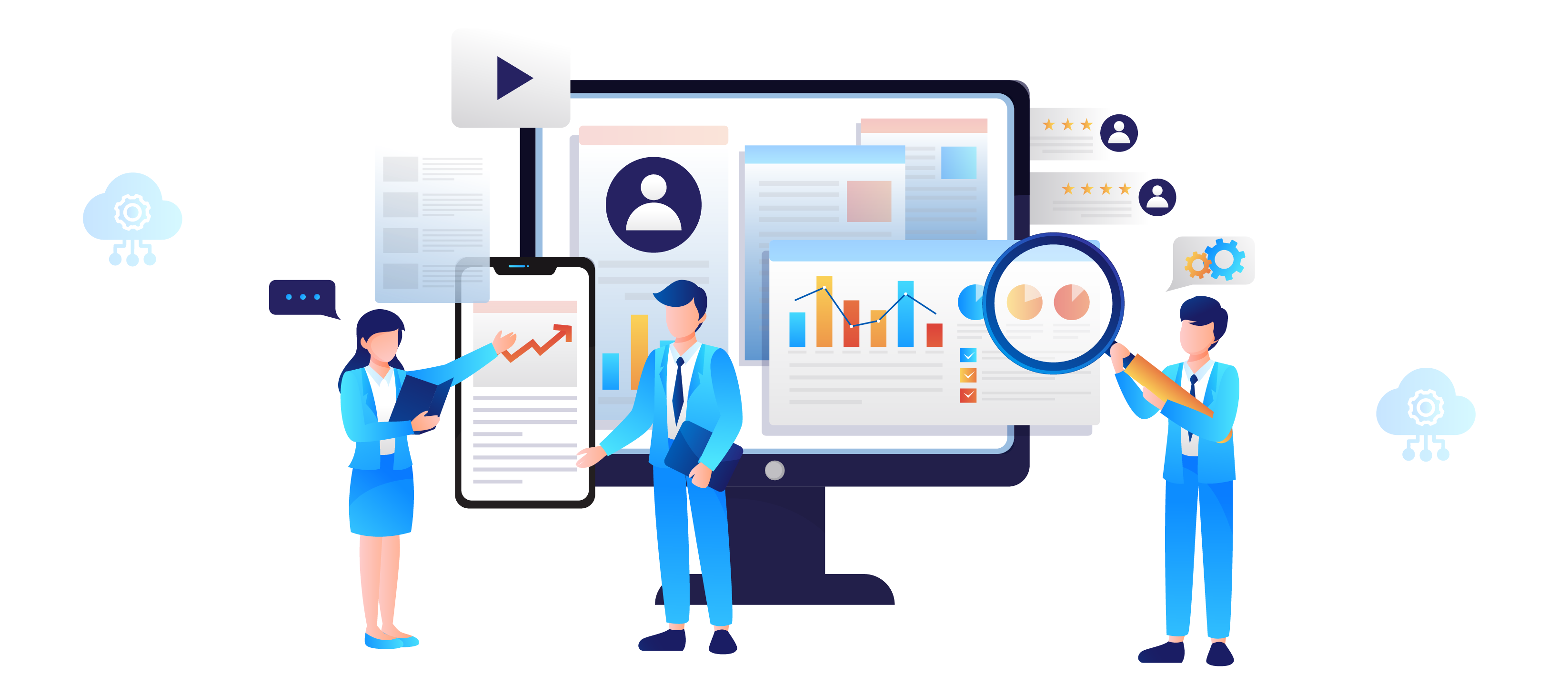Social Media’s Role in Operations Management: Enhancing Service & Forecasting
In the digital age, social media has transcended its original purpose of connecting people, becoming a pivotal tool in operations management. Its real-time nature and vast outreach capabilities have enabled businesses to enhance customer service and improve demand forecasting significantly. This article explores how integrating social media into operations management can transform these critical business functions.
The rise of social media has fundamentally reshaped our world, and its impact isn’t confined to personal interactions. It’s also transforming the way businesses operate, particularly in the realm of operations management. By fostering real-time communication, generating vast data
The Transformative Impact of Social Media on Customer Service
- Immediate Customer Interactions: Social media platforms provide a direct channel for customer communication, allowing for rapid responses that can improve customer satisfaction and retention.
- Public Feedback and Transparency: The public nature of social media feedback forces businesses to uphold high standards of service, turning customer service into a potential marketing advantage.
- Case Study Highlight: Example of a company that successfully managed a customer service crisis through effective social media strategies.
Social Media as a Tool for Enhanced Customer Engagement
- Building Relationships: Leveraging social media for regular engagement through content, polls, and interactive sessions, which helps maintain a connection and build brand loyalty.
- Customer Insights and Personalization: Analyzing customer interactions and feedback on social media to tailor services and offers, enhancing the customer experience and satisfaction.
- Practical Example: How a retail brand used social media polls to decide on new product features.

Leveraging Social Media for Demand Forecasting
- Real-Time Data Collection: Utilizing social media as a tool to gather real-time data on customer preferences and trends, which can be directly applied to improve the accuracy of demand forecasts.
- Predictive Analytics: Integrating social media data with predictive analytics tools to anticipate future demand based on current trends and discussions.
- Industry Case Study: A case study of a fashion brand that used social media trends to predict the next season’s popular colors and styles.
Social Media Integration with Traditional Operations Management Systems
- CRM Systems: Discussing the integration of social media data into Customer Relationship Management (CRM) systems to provide a holistic view of customer behaviors and preferences.
- Supply Chain Adjustments: How social media insights can lead to more agile supply chain responses, particularly in industries where demand can shift rapidly.
- Technology Spotlight: An overview of software that facilitates the integration of social media data into existing operational frameworks.
Challenges and Considerations in Adopting Social Media for Operations Management
- Data Overload and Privacy Concerns: Addressing the challenges of managing large volumes of data and maintaining customer privacy.
- Accuracy and Relevance: Ensuring the data derived from social media is accurate and relevant to specific operational needs.
- Best Practices: Tips on how to effectively navigate the pitfalls of social media integration in operations management.

Future Trends and the Evolving Role of Social Media in Operations Management
- Artificial Intelligence and Machine Learning: Exploring future advancements in AI and machine learning that could enhance the processing and utilization of social media data.
- Increased Automation: The potential for more automated systems that use social media data to make real-time operational decisions.
- Expert Opinions: Insights from industry leaders on the future trajectory of social media in operations management.
As businesses continue to navigate the complexities of the digital landscape, the role of social media in operations management is becoming increasingly significant. By enhancing customer service and refining demand forecasting, social media provides businesses with tools not just to react to market demands, but to anticipate and shape them. This proactive approach to operations management not only improves efficiency but also fosters a more dynamic and customer-focused business model.
Interested in integrating social media into your operations management strategy? Start by evaluating your current customer service and forecasting methods and consider how social media could bring real-time enhancements. As always, ensure any new tools or approaches are aligned with your broader business goals for maximum impact.
SaaS Growth: Effective Paid Advertising Strategies
In the fast-paced world of SaaS, organic growth might seem like the holy grail. Building genuine connections and attracting users through high-quality content and SEO prowess is undoubtedly valuable. But let’s face it, organic growth takes time, and for startups or companies striving for exponential scaling, paid advertising can be a potent growth accelerator.
While organic and paid advertising work best in tandem, mastering the paid realm offers distinct advantages:
- Faster User Acquisition: Reach highly targeted audiences quickly and efficiently, driving immediate sign-ups and conversions.
- Increased Brand Awareness: Put your brand in front of the right people, building recognition and establishing your presence in the market.
- Measurable Results: Track every click, conversion, and ROI with pinpoint accuracy, allowing for data-driven optimization and campaign improvements.
- Targeting Specificity: Laser-focus your campaigns on users with specific demographics, interests, and online behaviors, maximizing relevance and effectiveness.
But navigating the complex world of paid advertising can be daunting, especially for SaaS companies. This guide dives into key strategies to help you craft winning paid advertising campaigns for explosive SaaS growth:
Define Your Ideal Customer Persona:
Before diving into platforms and tactics, crystallize your target audience. Create detailed buyer personas that capture their demographics, pain points, online behavior, and decision-making process. This understanding will guide your ad targeting, messaging, and creative development.
Choose the Right Platforms:
The plethora of advertising platforms can be overwhelming. Start by assessing your target audience and their preferred channels. Popular options for SaaS include:
- Search Engine Marketing (SEM): Utilize platforms like Google Ads and Bing Ads to target users actively searching for keywords related to your product or industry.
- Social Media Advertising: Leverage platforms like Facebook, LinkedIn, and Twitter to reach users based on demographics, interests, and behaviors.
- Programmatic Advertising: Target specific websites and audiences through automated ad buying platforms like Google Display Network (GDN).
- Retargeting Ads: Reconnect with website visitors who haven’t converted yet, reminding them of your offering and nudging them towards signup.

Effective ad copy is the cornerstone of successful campaigns. Focus on clear, concise messaging that resonates with your target audience. Highlight your unique value proposition and address their pain points directly. Remember:
- Use strong CTAs (Calls to Action): Tell users what you want them to do next, whether it’s visiting your website, signing up for a free trial, or downloading a white paper.
- Test different variations: Experiment with different headlines, descriptions, and visuals to see what resonates best with your audience.
- Optimize Landing Pages:
Don’t send users to your homepage after clicking your ad. Create dedicated landing pages tailored to each campaign, ensuring a seamless and relevant experience. Optimize these pages for conversions with clear value propositions, strong calls to action, and user-friendly design.
Leverage Retargeting:
Don’t underestimate the power of retargeting. Capture website visitors who haven’t converted and follow them across the internet with relevant ads, reminding them of your offering and increasing conversion rates.
Utilize Remarketing Lists for Search Ads (RLSA):
Take retargeting a step further by tailoring your search ads to users who have previously interacted with your brand. This increases the likelihood they see your ad when searching for relevant keywords.
 Embrace Video Advertising:
Embrace Video Advertising:
Visuals capture attention, and video ads are particularly effective for SaaS companies. Show your product in action, highlight customer testimonials, and explain complex features in an engaging way.
Track, Analyze, and Optimize:
Paid advertising is an iterative process. Continuously monitor your campaign performance, analyze key metrics like click-through rates, conversion rates, and cost per acquisition. Use this data to identify areas for improvement and optimize your campaigns for better results.
Consider Partnering with Influencers:
Partnering with industry influencers can be a powerful way to reach a targeted audience and build trust. Choose influencers whose audience aligns with your ideal customer persona and collaborate on content creation or sponsored promotions.
Experiment and Stay Innovative:
Don’t be afraid to experiment with different platforms, ad formats, and targeting options. The advertising landscape is constantly evolving, so stay informed about new trends and be willing to test innovative approaches.
Bonus Tips for SaaS Success:
- Offer freemium trials or demos: Allow users to experience your product firsthand, lowering the barrier to entry and boosting conversions.
- Highlight data security and compliance: Address privacy concerns upfront, especially for businesses operating in sensitive industries.
Focus on customer success: Provide excellent customer support and onboard new users effectively to ensure they find value and stay subscribed
The Mental Game of Online Income: Staying Motivated and Avoiding Burnout
Creating an online income can be an exciting and rewarding endeavor. However, it also comes with its challenges, especially when it comes to staying motivated and avoiding burnout. The mental game of online income involves managing your mindset, finding motivation, and implementing strategies to prevent burnout. In this article, we will explore various techniques and practices that can help you stay motivated and maintain a healthy work-life balance while pursuing online income.
Understanding the Mental Challenges
The pursuit of online income can be mentally demanding. Often, individuals working online face unique challenges such as isolation, self-discipline, and the pressure to constantly prove oneself in a competitive online marketplace.
To overcome these challenges, it’s important to understand that the mental game plays a crucial role in your success. Building a strong mindset, finding intrinsic motivation, and establishing healthy habits can help you stay on track and avoid burnout.

Cultivating a Strong Mindset
A strong mindset is essential when it comes to the mental game of online income. It involves developing resilience, embracing challenges, and maintaining a positive attitude despite setbacks.
One effective approach is to reframe failures as learning opportunities. Instead of getting discouraged by mistakes or setbacks, view them as valuable lessons that can help you improve and grow. Cultivating a growth mindset allows you to see challenges as stepping stones to success.
Another important aspect of a strong mindset is practicing gratitude. Take a moment each day to reflect on what you are grateful for in your online income journey. This practice can help shift your focus from what’s not working to what is working, boosting your motivation and mental well-being.
Finding Intrinsic Motivation
Motivation is key to maintaining momentum in your online income journey. While external factors like financial rewards and success can provide temporary motivation, it’s intrinsic motivation that will keep you going over the long term.
Take the time to identify your “why” – the deep-rooted reasons behind your pursuit of online income. What drives you? Is it the desire for financial freedom, the ability to work on your own terms, or a passion for your chosen field? By connecting with your intrinsic motivation, you can tap into a source of sustainable energy and drive.
Keep your “why” visible and regularly revisit it as a reminder of what you are working towards. Visual cues like vision boards or written affirmations can serve as powerful motivation boosters during moments of doubt or fatigue.
Setting Realistic Goals and Priorities
Setting clear and realistic goals is essential for staying motivated and avoiding burnout. Break down your larger income goals into smaller, manageable milestones. Each milestone achieved can provide a sense of accomplishment and fuel further motivation.
It’s also important to prioritize your tasks and manage your time effectively. Online income pursuits can often involve multiple projects or streams of income, which can lead to overwhelm and burnout if not properly managed. Use productivity tools and techniques, such as time blocking or the Pomodoro Technique, to stay focused and organized.
Remember, it’s okay to say no and set boundaries. Prioritize tasks that align with your long-term goals and value your time. By setting realistic goals and prioritizing effectively, you can reduce the risk of burnout and maintain a healthy work-life balance.

Creating a Supportive Environment
Building a supportive environment is crucial for maintaining motivation and avoiding burnout. Surround yourself with like-minded individuals who understand the challenges of online income pursuits and can provide encouragement or guidance.
Online communities, such as forums or social media groups, can be great sources of support. Engage with others, share your experiences, and seek advice when needed. Connecting with others who are on a similar journey can help you feel less isolated and provide valuable insights and perspectives.
It’s also important to communicate your needs to friends and family members. Let them know about your online income pursuits and the specific challenges you face. By setting expectations and receiving support from loved ones, you can create a more positive and understanding environment.
Taking Care of Your Mental and Physical Well-being
Maintaining good mental and physical well-being is essential when it comes to the mental game of online income. It’s easy to neglect self-care when you’re focused on building your online income, but neglecting your well-being can lead to burnout and decreased motivation.
Prioritize activities that support your mental and physical health, such as exercise, meditation, or hobbies. Make time for breaks and relaxation. Remember, taking breaks can actually enhance productivity and creativity.
Ensure that you are getting enough sleep and paying attention to your nutrition. A well-rested body and a nourished mind are better equipped to tackle the challenges of online income and stay motivated.
Conclusion
The mental game of online income is just as important as the technical aspects of building an online income. By cultivating a strong mindset, finding intrinsic motivation, setting goals and priorities, creating a supportive environment, and taking care of your mental and physical well-being, you can stay motivated and avoid burnout.
Remember that building an online income is a journey, and there will be ups and downs along the way. Stay committed to your vision, stay flexible in your approach, and stay connected to your intrinsic motivation. With the right mindset and strategies, you can succeed in the online income world while maintaining a healthy work-life balance.
Breaking the Barriers: Making Money Online with Accessibility and Inclusivity in Mind
The internet holds a vast landscape of opportunities, promising financial freedom and entrepreneurial dreams. However, for many, navigating this landscape can be riddled with obstacles. Individuals with disabilities, diverse backgrounds, and limited resources often face barriers that hinder their ability to participate in the online economy.
This article aims to break down these barriers and empower everyone to explore the limitless possibilities of making money online, with a focus on accessibility and inclusivity.
Unveiling the Hidden Potential: Embracing Diversity in the Online Marketplace
The diversity of human experience presents a wealth of untapped potential. By creating online businesses that are accessible and inclusive, we unlock countless benefits:
- Expanding the customer base: Catering to diverse needs opens doors to a wider audience, increasing potential customers and boosting revenue.
- Innovation and fresh perspectives: Different experiences and viewpoints generate unique ideas and approaches, leading to innovative solutions and enhanced products.
- Building a stronger and more equitable society: Inclusivity breaks down social barriers and empowers individuals of all backgrounds to achieve financial independence.
Removing the Hurdles: Accessibility Practices for Online Businesses
Creating an accessible online experience is not just the right thing to do; it’s also good business. Here are some key practices to implement:
Website and Content:
- Screen reader compatibility: Ensure your website can be navigated and understood by screen readers used by blind and visually impaired individuals.
- Alt text for images: Describe images accurately using alt text, allowing visually impaired users to understand their content.
- Clear and concise language: Avoid jargon and overly complex sentence structures. Opt for plain language that everyone can understand.
- Color contrast: Maintain sufficient contrast between text and background colors for better readability by people with visual impairments.
- Keyboard navigation: Design your website to be fully navigable using only the keyboard, catering to users with mobility limitations.

Accessibility for Diverse Audiences:
- Multilingual options: Consider offering your content in multiple languages to reach a broader audience.
- Closed captions and transcripts: Add captions to videos and transcripts for audio content, making them accessible to deaf and hard-of-hearing individuals.
- Content warnings: Include warnings for potential triggers or sensitive content.
- Neurodiversity awareness: Design your content and interface to be clear, predictable, and less overwhelming for individuals with neurodiverse conditions.
Beyond the Website:
- Accessibility statements: Publicly declare your commitment to accessibility and outline the specific measures you have taken.
- Inclusive marketing: Represent diverse backgrounds and abilities in your marketing materials and avoid discriminatory language.
- Customer support: Train your customer support team to be sensitive to diverse needs and offer alternative communication methods like live chat or video calls.
Beyond technology:
- Accessibility audits: Regularly conduct accessibility audits to identify and address any potential barriers.
- Community outreach: Engage with disability rights organizations and diverse communities to gain valuable feedback and insights.

Breaking Barriers through Inclusive Business Models
There are numerous online business models that naturally lend themselves to inclusivity:
- Content creation: Start a blog, YouTube channel, or podcast catering to a specific niche within a diverse community.
- Freelancing: Offer your skills and expertise on platforms like Upwork or Fiverr, focusing on services that can be delivered online.
- E-commerce: Sell accessible products or cater to specific needs within diverse communities.
- Online education: Create and sell online courses or workshops targeting specific communities or offering accessible learning formats.
- Affiliate marketing: Promote accessible products or services that align with your values and audience.
Virtual assistant services: Offer remote administrative, technical, or creative assistance to businesses or individuals.
Overcoming Imposter Syndrome: Building Confidence and Success in the Online World
Imposter syndrome is a psychological pattern in which an individual doubts their accomplishments and has a persistent fear of being exposed as a fraud. This syndrome can be particularly prevalent in the online world, where individuals often compare themselves to others and feel inadequate. However, it is possible to overcome imposter syndrome and build confidence and success online. In this article, we will explore various strategies and techniques to overcome imposter syndrome and thrive in the online world.
Understanding Imposter Syndrome
Imposter syndrome can manifest in various ways, such as feeling like a fraud, doubting one’s abilities, and attributing success to luck rather than skill. In the online world, imposter syndrome can be exacerbated by the constant exposure to others’ achievements and the pressure to present oneself as successful.
To overcome imposter syndrome, it is essential to understand that many successful individuals experience these feelings. Recognizing that imposter syndrome is a common phenomenon can help to normalize these feelings and take steps towards building confidence.
Embrace your Uniqueness
One way to combat imposter syndrome is to embrace your uniqueness and recognize your strengths. In the online world, there are countless individuals with similar skills and interests, but what sets you apart is your unique perspective and experiences.
Take the time to reflect on your accomplishments and skills. Consider the challenges you have overcome and the unique perspective you bring. By acknowledging your strengths and embracing your uniqueness, you can build confidence and overcome imposter syndrome.

Set Realistic Goals
Setting realistic goals is essential for building confidence and achieving success in the online world. When setting goals, it is important to consider your capabilities and the resources available to you. Setting unrealistic goals can lead to feelings of inadequacy and reinforce imposter syndrome.
Break down your bigger goals into smaller, achievable tasks. Celebrate each milestone along the way, and acknowledge your progress. By setting realistic goals and focusing on achievable tasks, you can build confidence and overcome imposter syndrome.
Seek Support and Community
Building a support network is crucial for overcoming imposter syndrome. Surround yourself with individuals who uplift and encourage you. Seek out online communities of like-minded individuals who can offer support and guidance.
Engaging with others who share similar interests and goals can help to normalize imposter syndrome feelings and provide a sense of belonging. Connecting with others who have overcome imposter syndrome can be especially valuable, as they can share their experiences and strategies for building confidence and success.

Practice Self-Compassion
Self-compassion is an essential aspect of overcoming imposter syndrome. Treat yourself with kindness and understanding when experiencing self-doubt. Be mindful of your self-talk and challenge negative thoughts.
Acknowledge that everyone makes mistakes and experiences setbacks. Instead of dwelling on failures, focus on the lessons learned and the progress made. By practicing self-compassion, you can build resilience and overcome imposter syndrome.
Continuously Learn and Grow
The online world is constantly evolving, and it is crucial to continuously learn and grow to stay relevant and confident. Invest in your personal and professional development by taking online courses, attending webinars, or reading books on topics of interest.
By staying informed and expanding your knowledge, you can build confidence in your abilities and feel more secure in the online world. Embrace opportunities for growth and challenge yourself to step outside your comfort zone.

Celebrate Your Achievements
One effective way to combat imposter syndrome is to celebrate your achievements, no matter how small they may seem. Take the time to acknowledge and appreciate your accomplishments. Celebrate milestones, whether it’s reaching a certain number of followers, completing a project, or receiving positive feedback.
By celebrating your achievements, you reinforce your belief in your abilities and build confidence. Recognize that your successes are a result of your skills and hard work, rather than luck or chance.
Conclusion
Imposter syndrome is a common experience in the online world, but it is possible to overcome it and build confidence and success. By embracing your uniqueness, setting realistic goals, seeking support, practicing self-compassion, continuously learning, and celebrating your achievements, you can overcome imposter syndrome and thrive in the online world.
Remember, building confidence and success takes time and effort. Be patient with yourself and remember that you are capable of achieving great things. Harness the power of the online world to connect with others, learn from their experiences, and grow personally and professionally. You have the ability to overcome imposter syndrome and achieve your goals in the online world!
Future-Proofing Your Online Income: Adapting to New Trends and Emerging Opportunities
In the ever-evolving digital landscape, relying solely on one online income stream can be a risky proposition. Today’s booming trend might fade tomorrow, leaving you scrambling to catch up. Fortunately, proactive individuals can future-proof their online income by staying ahead of the curve and embracing emerging opportunities. This guide will equip you with the knowledge and actionable tips to adapt, diversify, and thrive in the face of digital changes.
Understanding the Need for Adaptability:
The online world is not static. Platforms rise and fall, algorithms shift, and consumer preferences evolve at breakneck speed. Just think of social media giants like MySpace or Vine, once dominant forces now relegated to the annals of internet history. What does this mean for your online income? Complacency is your enemy. Sticking to one outdated method or platform can leave you vulnerable to sudden drops in income or even complete obsolescence.
Key Trends Shaping the Future of Online Income:
To anticipate change, you need to understand the driving forces. Here are some key trends to keep an eye on:
- The Rise of the Creator Economy: Individuals creating and sharing content (text, videos, music, etc.) are increasingly monetizing their work through platforms like Patreon, Substack, and Twitch.
- Artificial Intelligence (AI) and Automation: AI is automating tasks across various industries, including online businesses. While some jobs might be replaced, new opportunities will arise in areas like AI training and content creation.
- The Metaverse and Web3: These emerging technologies promise immersive digital experiences and decentralized ownership, opening up new avenues for virtual goods, services, and monetization models.
- Focus on Community and Personalization: Building strong online communities and offering personalized experiences will be crucial to attracting and retaining audiences.

Adapting Your Online Income Strategy:
Now that you have a grasp of the evolving landscape, it’s time to take action. Here are some strategies to future-proof your online income:
- Diversify Your Income Streams:
Don’t put all your eggs in one basket. Explore different ways to make money online. This could include:
- Freelancing: Offer your skills (writing, design, marketing, etc.) on platforms like Upwork or Fiverr.
- Creating and selling digital products: eBooks, courses, templates, software, etc.
- E-commerce: Selling physical or digital products through your own store or marketplaces like Etsy.
- Affiliate marketing: Promoting other people’s products and earning commissions on sales.
- Investing in digital assets: Cryptocurrencies, NFTs, etc. (approach with caution and proper research).
Upskill and Reskill:
Stay relevant by continuously learning new skills and adapting to technological advancements. Take online courses, attend workshops, and network with other professionals to stay ahead of the curve. Consider learning in-demand skills like AI, blockchain technology, or virtual reality development.
- Embrace Emerging Technologies:
Explore how new technologies like AI, the Metaverse, and Web3 can enhance your online income potential. For example, you could use AI to create personalized content, participate in the Metaverse economy, or leverage Web3 for decentralized commerce.
- Build a Strong Online Community:
Develop a loyal audience by providing valuable content, interacting with them regularly, and fostering a sense of belonging. This will make your online business more resilient to changes in algorithms or platforms.
- Focus on Personalization:
Offer customized experiences to your audience, tailoring your content, products, and services to their specific needs and preferences. This will help you stand out from the competition and build stronger relationships with your customers.
Stay Informed and Be Proactive:
Keep yourself updated on the latest trends, news, and developments in the online space. Read industry blogs, attend webinars, and connect with other online entrepreneurs to stay ahead of the curve and anticipate changes.

Be Prepared for Change:
Accept that change is inevitable and be prepared to adapt your strategies as needed. Don’t be afraid to experiment, learn from your mistakes, and pivot your online business in response to new opportunities and challenges.
Remember: Future-proofing your online income is not a one-time event, but an ongoing process. By continuously learning, adapting, and embracing new trends, you can ensure your online business thrives in the ever-evolving digital landscape.
Bonus Tips:
- Build a strong personal brand: Your online presence should reflect your expertise, values, and unique selling proposition.
- Focus on providing value: Offer something unique and valuable to your audience, whether it’s information, entertainment, or a solution to their problem.
Network with other online entrepreneurs: Collaborate, share knowledge, and support each other in your online endeavors.
Tax Efficiency for Online Earners: Minimize Costs, Stay Compliant
The digital landscape has opened doors for countless individuals to earn income online. Whether you’re a freelancer, blogger, online seller, or influencer, navigating the world of taxes can feel overwhelming. While the freedom and flexibility of online work are undeniable, understanding and complying with tax regulations is crucial for avoiding penalties and maximizing your profits. This guide equips you with the knowledge to become tax-savvy, minimize costs, and navigate the complexities of online earnings.
Understanding Your Tax Classification:
The first step is determining your tax classification. Are you a sole proprietor, an independent contractor, or part of an LLC or corporation? Each classification carries different tax implications and filing requirements. Consult a tax professional to understand which category best fits your specific income stream.
Record Keeping & Documentation:
Meticulous record-keeping is paramount. Track all your income and expenses throughout the year. This includes:
- Income: Client payments, product sales, ad revenue, affiliate commissions, etc.
- Expenses: Website hosting, domain registration, software subscriptions, marketing costs, office supplies, travel expenses related to your business, etc.
Organize receipts, invoices, and bank statements for every transaction. This meticulousness simplifies tax preparation and ensures you don’t miss out on potential deductions.
Tax-Deductible Expenses:
Leverage tax-deductible expenses to lower your taxable income. Common deductions for online earners include:
- Home office expenses: A portion of rent, utilities, and internet bills if you dedicate a space exclusively for your business.
- Equipment and software: Computers, printers, subscriptions to relevant software programs.
- Marketing and advertising costs: Website promotion, social media advertising, business cards, etc.
- Education and training expenses: Courses, workshops, and conferences related to your online business.
- Travel expenses: Costs associated with business travel, including transportation, lodging, and meals.
Remember, these are just examples, and specific deductions may vary depending on your location and type of business. Consult a tax professional for personalized guidance on maximizing your deductions.
Estimated Tax Payments:
As an online earner, you’re typically responsible for making estimated tax payments throughout the year, rather than waiting until tax filing season. This avoids potential penalties and ensures you pay your taxes evenly throughout the year.
Staying Compliant with Regulations:
Beyond tax obligations, online earners must adhere to various regulations depending on their location and industry. For instance, e-commerce sellers may need to collect sales tax in specific states, while influencers might have disclosure requirements for sponsored content. Research and comply with regulations relevant to your specific online activity.
Additional Tips for Minimizing Costs:
- Embrace free resources: There are numerous free online tools and resources for managing finances, bookkeeping, and creating invoices. Leverage these before subscribing to paid solutions.
- Negotiate rates: Don’t be afraid to negotiate your rates with clients or platforms. Remember, your time and expertise are valuable.
- Outsource strategically: Consider outsourcing tasks like bookkeeping or social media management if it frees up your time to focus on higher-earning activities.
- Stay informed: Keep yourself updated on changes in tax laws and regulations that may impact your online business. Utilize resources like the IRS website or consult a tax professional.
Remember: This guide provides general information and should not be considered tax advice. Consulting a qualified tax professional is crucial for personalized guidance and ensuring you comply with all tax regulations relevant to your specific situation. By staying informed, keeping meticulous records, and leveraging deductions strategically, you can navigate the world of online earnings confidently, minimize your tax burden, and maximize your profits.
Data-Driven Decisions: Tracking Your Online Income and Optimizing Your Strategies
In the ever-evolving digital landscape, success doesn’t hinge on hunches or guesswork. In today’s data-driven world, the key to maximizing your online income lies in tracking your earnings and using those insights to optimize your strategies. Like a treasure map guiding an explorer, data analytics illuminate the path towards increased revenue and sustainable growth.
This article empowers you to become the captain of your own online financial journey. We’ll delve into the essential steps of tracking your online income, unveil key metrics to monitor, and explore powerful strategies for optimization based on data-driven insights.
Step 1: Charting Your Course: Choose the Right Tools
Before embarking on your data-driven adventure, equip yourself with the right tools. Popular options include:
- Financial Tracking Apps: Mint, QuickBooks, or personal spreadsheets help consolidate income and expenses from various sources.
- Website Analytics Tools: Google Analytics, Squarespace Analytics, or Shopify Analytics track website traffic, user behavior, and conversions.
- Affiliate Marketing Platforms: ClickBank, ShareASale, or CJ Affiliate provide detailed statistics on clicks, conversions, and commissions earned.
- Social Media Analytics: Facebook Insights, Twitter Analytics, or Instagram Insights offer audience demographics, engagement metrics, and reach data.
Step 2: Unveiling the Treasure: Key Metrics to Track
Now, let’s unveil the key metrics that act as your gold nuggets:
- Income Sources: Categorize your income streams (e.g., product sales, advertising revenue, affiliate commissions, freelance work). Quantify each source to understand their individual contribution.
- Traffic Sources: Identify where your website visitors or customers come from (e.g., organic search, social media, paid ads, referrals). This helps allocate resources to the most effective channels.
- Conversion Rates: Track the percentage of visitors who take a desired action (e.g., purchase, subscription, sign-up). Optimize your content and campaigns to improve conversions.
- Customer Acquisition Cost (CAC): Calculate the average cost to acquire a new customer. Focus on reducing CAC while increasing ROI (Return on Investment).
- Engagement Metrics: Monitor key engagement indicators like social media likes, shares, comments, and email open rates. Higher engagement signals potential leads and future conversions.
- Customer Lifetime Value (CLTV): Measure the average revenue generated by a customer throughout their relationship with you. Increase CLTV through loyalty programs and retargeting strategies.
- Abandoned Cart Rate: Track the percentage of users who add items to their cart but don’t complete the purchase. Optimize checkout processes and address checkout hurdles.

Step 3: Optimizing for Riches: Data-Driven Strategies
With your treasure map ready, let’s unlock the power of data-driven optimization:
- A/B Testing: Experiment with different website layouts, calls to action, or email subject lines to see which generates more conversions. Data reveals the winning strategy.
- Content Optimization: Analyze audience engagement data to identify high-performing content formats and topics. Focus on creating more of what resonates with your audience.
- Paid Advertising Optimization: Use data to refine your targeting, adjust bids, and experiment with different ad formats to improve ROI on paid advertising campaigns.
- Social Media Optimization: Analyze engagement metrics to understand which content types and posting times resonate best with your social media audience. Adapt your strategy accordingly.
- Personalization: Leverage data to personalize your offerings and communication based on user preferences and purchase history. This creates a more relevant and engaging experience.
- Influencer Marketing: Identify and collaborate with influencers whose audience aligns with your target market. Data helps track campaign performance and ROI.
- SEO Optimization: Analyze keyword performance data to identify high-value keywords and optimize your website content to rank higher in search engine results, driving organic traffic.
Step 4: The Journey Continues: Continuous Monitoring and Iteration
Remember, data-driven optimization is an ongoing journey, not a one-time destination. Regularly monitor your key metrics, analyze trends, and adapt your strategies accordingly. Embrace small, iterative changes based on data insights, and over time, you’ll witness a significant increase in your online income.
Beyond the Numbers: The Human Touch
While data plays a crucial role, don’t neglect the human element. Qualitative feedback from customers, surveys, and focus groups can offer valuable insights that complement quantitative data. Use a balanced approach to gain a holistic understanding of your audience and optimize your offerings effectively.
Conclusion:
By embracing data-driven decision-making, you unlock the power to transform your online ventures into flourishing enterprises. Equip yourself with the right tools, track key metrics, and implement optimization strategies based on insights
The Power of Partnerships: Collaborating with Other Online Businesses for Mutual Growth
In the ever-evolving landscape of online business, competition is fierce. But amidst the struggle to climb the ranks, a powerful strategy emerges: collaboration. Partnering with other online businesses can unlock a hidden potential for mutual growth, propelling both parties towards shared success. This article delves into the reasons why collaboration works, explores different types of partnerships, and offers practical tips to initiate and nurture successful alliances.
Why Collaborate?
The benefits of online business partnerships are manifold and extend far beyond simply increasing market share. Here are some key reasons why joining forces can be a game-changer:
- Expanded Reach and Audience: Accessing new customer segments is a constant challenge. Partnerships provide a gateway to your partner’s established audience, exposing your brand to a wider group of potential customers who might not have found you otherwise. This cross-pollination of audiences benefits both parties, leading to increased brand awareness and customer acquisition.
- Enhanced Credibility and Trust: Partnering with reputable businesses strengthens your brand image by association. By aligning yourself with complementary companies, you project a sense of authority and expertise, fostering trust and confidence in your own offerings.
- Combined Resources and Expertise: No business has all the answers. Collaboration allows you to leverage your partner’s unique strengths and resources, filling in gaps in your own knowledge or skillset. This can be anything from technological expertise to marketing reach, ultimately leading to improved product development, innovation, and overall efficiency.
- Cost-Effective Growth: Building your brand and acquiring customers can be expensive. Partnerships allow you to share marketing efforts, co-host events, or jointly develop content, effectively stretching your marketing budget further and maximizing your return on investment.
- Innovation and Problem-Solving: Bringing together diverse perspectives fosters a breeding ground for creative solutions. By collaborating on projects, you can tackle challenges from different angles, leading to innovative approaches and breakthroughs that might not have been possible individually.
.jpg)
Types of Partnerships:
The world of online collaboration offers a variety of avenues to explore. Here are some common partnership models:
- Co-marketing: This involves combining resources and expertise to promote each other’s products or services through joint marketing campaigns, social media collaborations, or co-hosted webinars.
- Influencer marketing: Partnering with established influencers in your niche allows you to tap into their engaged audience and leverage their credibility to promote your brand.
- Affiliate marketing: In this model, you offer a commission to your partner for every sale they generate through their promotional efforts.
- Strategic alliances: Long-term collaborations involving joint product development, technology sharing, or market expansion efforts.
- Joint ventures: This entails creating a separate entity owned and operated by both partners, allowing for deeper collaboration and shared profits on specific projects.
Building Successful Partnerships:
Finding the right partner is crucial. Look for businesses that share your target audience, values, and long-term vision. Here are some steps to follow:
- Identify common goals and objectives: Clearly define what each party hopes to achieve through the partnership. Aligned goals ensure everyone is working towards the same outcome.
- Negotiate a clear agreement: Outline the terms of the partnership, including roles, responsibilities, revenue sharing, and dispute resolution mechanisms. A formal agreement fosters transparency and avoids misunderstandings.
- Open communication and collaboration: Regularly communicate with your partner, share information, and actively collaborate on projects. Transparency and trust are essential for a successful partnership.
- Measure and track results: Establish clear metrics to track the success of your partnership. Regularly analyze data and adjust your strategy as needed to ensure you’re both achieving your goals.

Examples of Successful Collaborations:
The power of online business partnerships is evident in countless success stories. Here are a few examples:
- Spotify and Starbucks: This partnership allows Starbucks customers to pay for their coffee and stream Spotify seamlessly, offering a convenient and personalized experience for both brands.
- Netflix and YouTube: Netflix partnered with YouTube to create personalized trailers and recommendations, leveraging YouTube’s vast audience to promote new content and drive subscriptions.
- Warby Parker and TOMS: These eyewear companies collaborated on a limited-edition collection, raising awareness for eye care charities and expanding their respective customer bases.
Conclusion:
In a fiercely competitive online landscape, collaboration is not just an option, it’s a strategic imperative. By joining forces with the right partners, you can unlock exciting opportunities for mutual growth, expand your reach, enhance your brand image, and drive innovation. So, step outside the silo, embrace the power of collaboration, and watch your online business reach new heights together.
Unlocking Social Media Monetization: Strategies for Influencers and Creators
The online landscape is evolving, and so are the ways influencers and creators generate income. While advertising has long been the cornerstone of social media monetization, it’s becoming increasingly clear that relying solely on ads isn’t sustainable. Platforms are changing algorithms, user privacy is a growing concern, and audiences are becoming more ad-averse.
So, how can creators thrive in this dynamic environment? The answer lies in thinking beyond traditional advertising and exploring diverse monetization strategies. This article will equip you with six powerful strategies to unlock your earning potential and build a financially sustainable career as a social media influencer or creator.
1. Cultivate a Strong, Engaged Community
At the heart of any successful monetization strategy lies a loyal and engaged community. Focus on building genuine connections with your audience, providing value consistently, and fostering a sense of belonging. Here’s how:
- Create high-quality, authentic content that resonates with your target audience.
- Engage with your followers by responding to comments, hosting Q&As, and running interactive polls.
- Collaborate with other creators for cross-promotion and audience expansion.
- Host live streams and virtual events to directly connect with your community.
- Utilize Patreon or other membership platforms to offer exclusive content and benefits to dedicated supporters.
By cultivating a strong community, you build trust and loyalty, making your audience more receptive to your monetization efforts.

2. Leverage the Power of Branded Collaborations
Strategic partnerships with brands can be a lucrative way to monetize your social media presence. However, move beyond simple product endorsements and focus on creating authentic collaborations that align with your brand values and resonate with your audience. Here are some options:
- Develop co-branded products or services with relevant brands.
- Create sponsored content that seamlessly integrates with your usual content style.
- Become a brand ambassador and represent a brand for a sustained period.
- Host branded events or workshops to directly engage with potential customers.
- Offer affiliate marketing opportunities where you earn commission on sales generated through your unique code.
Remember, transparency is key. Always disclose sponsored content and partnerships clearly, ensuring they contribute genuinely to your overall content strategy.
3. Embrace Digital Products and Services
Selling your own digital products or services can be a scalable and sustainable way to earn income. Consider these options:
- Develop and sell online courses, ebooks, or templates related to your expertise.
- Offer one-on-one coaching, consulting, or mentorship to your audience.
- Create paid webinars or workshops on specific topics relevant to your niche.
- Design and sell digital downloads like printables, stickers, or music.
- Offer stock photos, video footage, or audio recordings you create.
By leveraging your knowledge and skills, you can create valuable offerings that resonate with your audience and provide a recurring income stream.
4. Explore Subscription Models
Subscription models have gained traction, allowing creators to offer exclusive content and benefits to paying subscribers. Consider implementing this through platforms like:
- Patreon: Offer tiered subscriptions with varying levels of access to exclusive content.
- Substack: Share longer-form written content or newsletters exclusive to subscribers.
- Twitch or YouTube Memberships: Offer exclusive live streams, emotes, and badges to paying members.
- Discord server subscriptions: Create private channels and perks for paying members within your Discord community.
Subscription models foster deeper community engagement and provide a predictable income stream, allowing you to focus on creating high-quality content for your paying supporters.
5. Utilize Virtual Tipping and Donations
Platforms like Twitch, YouTube, and Clubhouse now offer virtual tipping features where viewers can directly send creators monetary support. Additionally, consider platforms like:
- Ko-fi: Allow fans to send one-time donations or pay for specific content pieces.
- Buy Me a Coffee: Accept small donations as a gesture of appreciation.
- Venmo or PayPal: Provide direct payment options for supporters who prefer them.
While individual amounts may be small, these platforms can accumulate significant income over time and signify direct appreciation from your audience.

6. Embrace Live Commerce and Influencer Marketing
Live commerce is exploding, allowing creators to sell products directly during live streams. Platforms like:
- Instagram Live Shopping: Showcase and sell products directly during live streams.
- TikTok Live Shopping: Partner with brands to feature and sell products within your live streams.
Amazon Live: Promote and sell Amazon products in real-time with interactive features.











